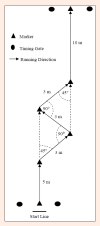Reliability and Validity of a New Test of Change-of-Direction Speed for Field-Based Sports: the Change-of-Direction and Acceleration Test (CODAT)
- PMID: 24149730
- PMCID: PMC3761765
Reliability and Validity of a New Test of Change-of-Direction Speed for Field-Based Sports: the Change-of-Direction and Acceleration Test (CODAT)
Abstract
Field sport coaches must use reliable and valid tests to assess change-of-direction speed in their athletes. Few tests feature linear sprinting with acute change- of-direction maneuvers. The Change-of-Direction and Acceleration Test (CODAT) was designed to assess field sport change-of-direction speed, and includes a linear 5-meter (m) sprint, 45° and 90° cuts, 3- m sprints to the left and right, and a linear 10-m sprint. This study analyzed the reliability and validity of this test, through comparisons to 20-m sprint (0-5, 0-10, 0-20 m intervals) and Illinois agility run (IAR) performance. Eighteen Australian footballers (age = 23.83 ± 7.04 yrs; height = 1.79 ± 0.06 m; mass = 85.36 ± 13.21 kg) were recruited. Following familiarization, subjects completed the 20-m sprint, CODAT, and IAR in 2 sessions, 48 hours apart. Intra-class correlation coefficients (ICC) assessed relative reliability. Absolute reliability was analyzed through paired samples t-tests (p ≤ 0.05) determining between-session differences. Typical error (TE), coefficient of variation (CV), and differences between the TE and smallest worthwhile change (SWC), also assessed absolute reliability and test usefulness. For the validity analysis, Pearson's correlations (p ≤ 0.05) analyzed between-test relationships. Results showed no between-session differences for any test (p = 0.19-0.86). CODAT time averaged ~6 s, and the ICC and CV equaled 0.84 and 3.0%, respectively. The homogeneous sample of Australian footballers meant that the CODAT's TE (0.19 s) exceeded the usual 0.2 x standard deviation (SD) SWC (0.10 s). However, the CODAT is capable of detecting moderate performance changes (SWC calculated as 0.5 x SD = 0.25 s). There was a near perfect correlation between the CODAT and IAR (r = 0.92), and very large correlations with the 20-m sprint (r = 0.75-0.76), suggesting that the CODAT was a valid change-of-direction speed test. Due to movement specificity, the CODAT has value for field sport assessment. Key pointsThe change-of-direction and acceleration test (CODAT) was designed specifically for field sport athletes from specific speed research, and data derived from time-motion analyses of sports such as rugby union, soccer, and Australian football. The CODAT features a linear 5-meter (m) sprint, 45° and 90° cuts and 3-m sprints to the left and right, and a linear 10-m sprint.The CODAT was found to be a reliable change-of-direction speed assessment when considering intra-class correlations between two testing sessions, and the coefficient of variation between trials. A homogeneous sample of Australian footballers resulted in absolute reliability limitations when considering differences between the typical error and smallest worthwhile change. However, the CODAT will detect moderate (0.5 times the test's standard deviation) changes in performance.The CODAT correlated with the Illinois agility run, highlighting that it does assess change-of-direction speed. There were also significant relationships with short sprint performance (i.e. 0-5 m and 0-10 m), demonstrating that linear acceleration is assessed within the CODAT, without the extended duration and therefore metabolic limitations of the IAR. Indeed, the average duration of the test (~6 seconds) is field sport-specific. Therefore, the CODAT could be used as an assessment of change-of-direction speed in field sport athletes.
Keywords: Illinois agility run; Lateral cutting; field testing; linear speed; team sports.
Figures
References
-
- Bangsbo J., Nørregaard L., Thorsø F. (1991) Activity profile of competition soccer. Canadian Journal of Sport Sciences 16, 110-116 - PubMed
-
- Baumgartner T.A., Chung H. (2001) Confidence limits for intraclass reliability coefficients. Measurement in Physical Education and Exercise Science 5, 179-188
-
- Beekhuizen K.S., Davis M.D., Kolber M.J., Cheng M.S. (2009) Test-retest reliability and minimal detectable change of the hexagon agility test. Journal of Strength and Conditioning Research 23, 2167-2171 - PubMed
-
- Buchheit M., Lefebvre B., Laursen P.B., Ahmaidi S. (2011) Reliability, usefulness, and validity of the 30-15 Intermittent Ice Test in young elite ice hockey players. Journal of Strength and Conditioning Research 25, 1457-1464 - PubMed
LinkOut - more resources
Full Text Sources


